Fiorini
 Monday, March 12, 2012 at 01:01PM
Monday, March 12, 2012 at 01:01PM 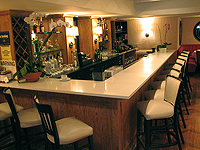
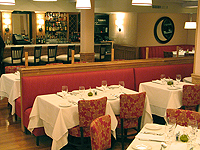
 Among families in the restaurant business, it is hard to find a starker contrast than the Arpaias: the under-publicized Lello; and his glamorous, photogenic daughter Donatella, who is often in the news, a fixture on the Food Network, and is seldom out of mind at her restaurants—because most of them are named after her.
Among families in the restaurant business, it is hard to find a starker contrast than the Arpaias: the under-publicized Lello; and his glamorous, photogenic daughter Donatella, who is often in the news, a fixture on the Food Network, and is seldom out of mind at her restaurants—because most of them are named after her.
 But we never would’ve heard of Donatella, had it not been for her father, who has quietly put together a four-decade career at a series of upscale, old-school, classic Italian restaurants. He has closed a few, but they’ve all had multi-year runs, mostly successful, and without an outright failure. His current flagship is Fiorini, named for a monetary unit in nineteenth-century Tuscany. (Another Arpaia, Donatella’s older brother Dino, runs nearby Cellini.)
But we never would’ve heard of Donatella, had it not been for her father, who has quietly put together a four-decade career at a series of upscale, old-school, classic Italian restaurants. He has closed a few, but they’ve all had multi-year runs, mostly successful, and without an outright failure. His current flagship is Fiorini, named for a monetary unit in nineteenth-century Tuscany. (Another Arpaia, Donatella’s older brother Dino, runs nearby Cellini.)
The few professional reviews of Fiorini are overly fixated on price. New York says it’s “Italian…aimed at the expense-account set.” Time Out says it’s “a neighborhood restaurant in a neighborhood with money to burn,” with “steep prices.” Menupages gives it five dollar signs ($$$$$), the same as Per Se. Zagat says “it’s ‘on the short list’ for ‘adult’ locals who don’t mind that checks are ‘a bit steep.’”
Time for a reality check. Antipasti and salads at Fiorini are $9–14, pastas $19–23, entrées mostly $24–30 (only two veal dishes surpass that amount). That’s about the same as you’ll pay at the city’s better known two-star Italian restaurants, such as Peasant, Locanda Verde, or Spigolo (to name a few), and no one has ever referred to those establishments as expense-account places.
And of course, you can easily pay far more than that for Italian cuisine in NYC, including some restaurants that are worth it (like Del Posto or Marea), and many that are not (like Nello or Harry Cipriani).
I would classify Fiorini as a bargain, assuming you’re in the market for what Mr. Arpaia is selling: very good traditional Italian cuisine in a comfortable, elegant, but slightly old-fashioned midtown dining room. This, to be fair, is a product that most of the city’s professional critics do not care for, which is why the prices grab their attention, when at any number of identically priced but more fashionable restaurants, they do not.
Full disclosure: I dined at Fiorini at the publicist’s invitation and did not pay for my meal. The kitchen sent out a nine-course “tasting menu”—a format the restaurant does not normally offer—consisting mostly of smaller-sized portions of dishes from their regular menu.

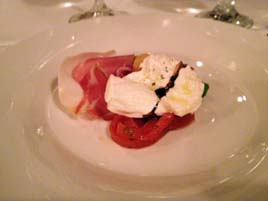
1. Polpo Ai Ferri (above left; grilled Mediterranean octopus, tomato, caper berries, olives, arugula, red onions). This was one of the better octopus dishes I’ve had in a while.
2. Burrata (above right; creamy imported mozzarella, roasted peppers, asparagus, prosciutto di Parma). This was some of the softest, sweetest burrata around, and I liked the textural contrast with the prosciutto.
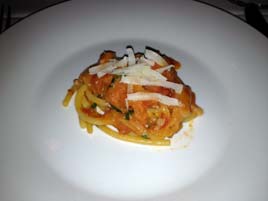
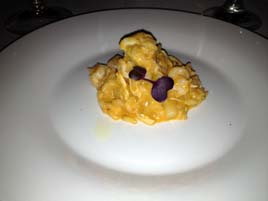
3. Bucatini alla Matriciana (above left; San Marzano tomato sauce, imported pancetta, onions, Pecorino Romano).
4. Risotto ai Frutti di Mare (above right; Super fino arborio rice, jumbo lump crabmeat, diver scallops, ocean shrimp, calamari, seafood broth).
The reduced portion size didn’t quite do the two pasta/rice dishes justice; in particular, I couldn’t really make out all of the ingredients in the risotto, though the bucatini were pretty good.
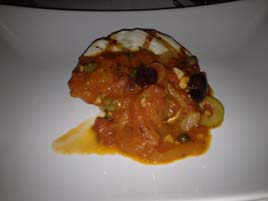
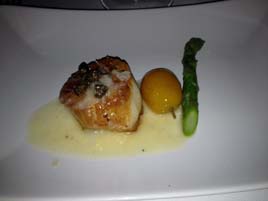
5. Pesce Spada Livornese (above left; grilled swordfish, imported olives, onions, capers, and tomato sauce). The swordfish had a terrific smoky flavor, but in the smaller portion size was a bit too dry.
6. Cappesante (above right; pan-seared diver scallops, caper berries, lemon, white wine, fresh parsley). This was the best of the savory courses, aided by the plump, juicy scallop, with wonderful contrast from the caper berries and a candied apricot on the side.
7. Petto D’Anatra (below left; pan-seared duck breast with Bartlett poached pears in a dry vermouth sauce). This was a beautiful, rich portion of duck, though the sauce was not as memorable as the one given the scallop.
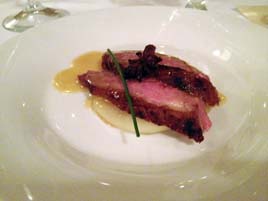

8. Zucotto (above right; three chocolate and passion-fruit mousse cake).
9. Baba (below left; sponge cake, hint of rum, Marsala wine, Mascarpone cheese custard).
10. Plate of Biscotti (below right).
The desserts were exemplary (and were served in full-size portions). I especially liked the Zucotto. I haven’t many examples for comparison, but I finished all of it despite not being a chocolate lover. The Baba was just fine, but it’s hard to avoid comparisons with Alain Ducasse at the Essex House, where they brought around a cart with a dozen aged rums to choose from. It’s no fault of Mr. Arpaia that Fiorini can’t duplicate this. Here, they supply the rum on the side, and you decide how much to add: I poured in the whole glass, unapologetically.
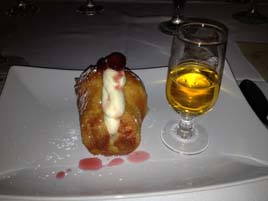
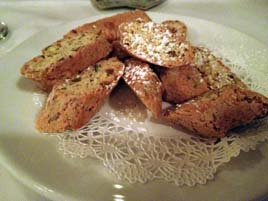
As I have noted in past reviews, old-school upscale Italian is the most over-represented cuisine in the city. Even if this were not an invited review (with all of the freighted conflicts it brings), it would be difficult to articulate precisely how this restaurant sets itself apart from others of comparable quality. I’d need to spend a month eating Italian every night, before I could tell you that, so I’ll leave you with the following:
A meal here may give the impression of a trip in the wayback machine, given the trends in contemporary dining. But for old-fashioned Italian elegance there are few better than Lello Arpaia.
Fiorini (209 East 56th Street between Second & Third Avenues, East Midtown)


